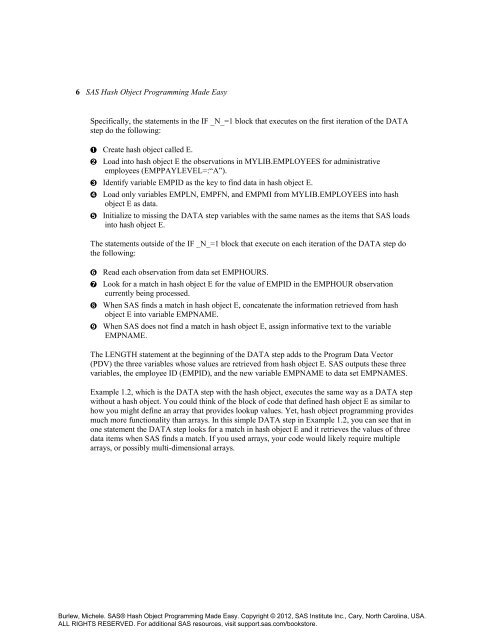SAS® Hash Object Programming
SAS® Hash Object Programming
SAS® Hash Object Programming
Create successful ePaper yourself
Turn your PDF publications into a flip-book with our unique Google optimized e-Paper software.
6 SAS <strong>Hash</strong> <strong>Object</strong> <strong>Programming</strong> Made Easy<br />
Specifically, the statements in the IF _N_=1 block that executes on the first iteration of the DATA<br />
step do the following:<br />
➊ Create hash object called E.<br />
➋ Load into hash object E the observations in MYLIB.EMPLOYEES for administrative<br />
employees (EMPPAYLEVEL=:“A”).<br />
➌ Identify variable EMPID as the key to find data in hash object E.<br />
➍ Load only variables EMPLN, EMPFN, and EMPMI from MYLIB.EMPLOYEES into hash<br />
object E as data.<br />
➎ Initialize to missing the DATA step variables with the same names as the items that SAS loads<br />
into hash object E.<br />
The statements outside of the IF _N_=1 block that execute on each iteration of the DATA step do<br />
the following:<br />
➏ Read each observation from data set EMPHOURS.<br />
➐ Look for a match in hash object E for the value of EMPID in the EMPHOUR observation<br />
currently being processed.<br />
❽ When SAS finds a match in hash object E, concatenate the information retrieved from hash<br />
object E into variable EMPNAME.<br />
➒ When SAS does not find a match in hash object E, assign informative text to the variable<br />
EMPNAME.<br />
The LENGTH statement at the beginning of the DATA step adds to the Program Data Vector<br />
(PDV) the three variables whose values are retrieved from hash object E. SAS outputs these three<br />
variables, the employee ID (EMPID), and the new variable EMPNAME to data set EMPNAMES.<br />
Example 1.2, which is the DATA step with the hash object, executes the same way as a DATA step<br />
without a hash object. You could think of the block of code that defined hash object E as similar to<br />
how you might define an array that provides lookup values. Yet, hash object programming provides<br />
much more functionality than arrays. In this simple DATA step in Example 1.2, you can see that in<br />
one statement the DATA step looks for a match in hash object E and it retrieves the values of three<br />
data items when SAS finds a match. If you used arrays, your code would likely require multiple<br />
arrays, or possibly multi-dimensional arrays.<br />
Burlew, Michele. <strong>SAS®</strong> <strong>Hash</strong> <strong>Object</strong> <strong>Programming</strong> Made Easy. Copyright © 2012, SAS Institute Inc., Cary, North Carolina, USA.<br />
ALL RIGHTS RESERVED. For additional SAS resources, visit support.sas.com/bookstore.

















